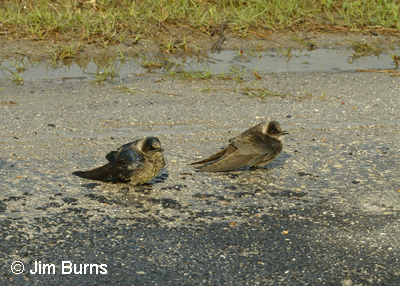
This past Easter Sunday I was standing on a paved secondary road through a marsh on the coast of Texas. It had rained from 5:00pm the previous evening until 7:00am that morning, it was 45 degrees with a cold north wind blowing steady at 20 mph, and a thin sun was playing tag with thick, billowy clouds as the norther blew itself out. Purple martins, the largest of our swallows and one of the earliest and most beloved harbingers of spring in the east, were lying exhausted on the roadbed all around me, soaking up the reflected heat, trying to dry out their feathers, many of them dying, some already dead. Not a happy Easter for them.
Purple martins are one of our long distance migrants, spending winters in the Amazon River basin in South America. They return to Arizona in April and May, but often show up in the east as early as late February where late winters and springtime storms like the one I witnessed are just one, but perhaps the most lethal, of the myriad obstacles migratory birds encounter, natural predators, communication towers, and loss of traditional, food rich stopover habitats being some of the others.
Our swallows and martins are perhaps the quintessential aerialists, their long, pointed wings evolved for the graceful arcs, and instant but fluid directional changes that allow them to forage on flying insects which they capture in their huge mouths. Rarely seen perched in repose, almost never seen on the ground, these constantly active birds truly embody the freedom of flight, and to see them lying helpless and unable to move out of the way of the occasional passing vehicle was a shocking reminder of the perils of migration.
Migratory movements are the most energy expensive and stressful activities of our birds. Spring migration, though more observable and more eagerly awaited by us as a release from our own winter, is far the more costly of birds' two annual movements. During fall migration, protracted and leisurely, migrants travel as the winds, the weather patterns, and food supplies take them. Spring migration is driven by their greatest biological urge, the urge to breed, nest, and raise young before insects disappear from northerly latitudes. This urge does not defer to late winters, spring storms, predators, nor our relatively recent intrusion into nature's annual cycles.
Spring migration may be the main event on the calendar for both birds and birders, but birders should not overlook the reality lurking beneath the veneer of excitement and beauty it provides for our species. We are all migrants here, all related, all interconnected, all in this together.